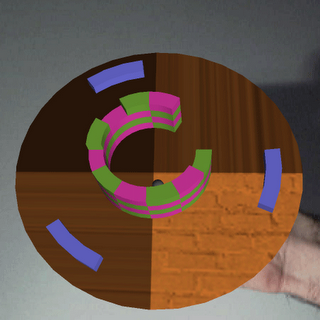In this month’s issue of the journal of Simulation & Gaming (December 1 2006, Volume 37, No. 4), I have published an article with title 'An exploration from virtual to augmented reality gaming'.
The paper first presents the requirements of modern gaming applications and proposes a classification of the most significant game design issues. Next, to realise the issues related to video and virtual reality gaming, an interactive game engine is designed. As a case study a traditional two-dimensional arcade game, called Breakout, is implemented into a virtual environment.
Collision detection is supported between the graphics components of the application based on Newton laws of physics. To test the effectiveness of our approach, a tangible platform for playing interactive three-dimensional games using video see-through augmented reality techniques is proposed.
The paper first presents the requirements of modern gaming applications and proposes a classification of the most significant game design issues. Next, to realise the issues related to video and virtual reality gaming, an interactive game engine is designed. As a case study a traditional two-dimensional arcade game, called Breakout, is implemented into a virtual environment.
Collision detection is supported between the graphics components of the application based on Newton laws of physics. To test the effectiveness of our approach, a tangible platform for playing interactive three-dimensional games using video see-through augmented reality techniques is proposed.
The above screenshot illustrates how a user can manipulate the Breakout simulation using his hand in real-time. This allows getting the best viewpoint in a natural and realistic manner. Similarly, the player can move the AR Breakout closer to the camera (and vice-versa) to zoom into the game.
Moreover, a pilot study evaluated six important issues of each application including: efficiency; usefulness; realism; learning; interaction and camera movement. Initial results illustrated that players preferred the VR Breakout in terms of efficiency and the AR Breakout in terms of game play and ease of interactions. Overall, the AR version seems to have all the necessary potentials to become an alternative platform for future gaming applications.
For more information, a draft version of the article can be downloaded from here.
Moreover, a pilot study evaluated six important issues of each application including: efficiency; usefulness; realism; learning; interaction and camera movement. Initial results illustrated that players preferred the VR Breakout in terms of efficiency and the AR Breakout in terms of game play and ease of interactions. Overall, the AR version seems to have all the necessary potentials to become an alternative platform for future gaming applications.
For more information, a draft version of the article can be downloaded from here.
